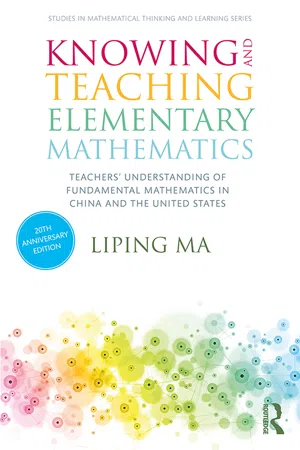
Knowing and Teaching Elementary Mathematics
Teachers' Understanding of Fundamental Mathematics in China and the United States
- 230 pages
- English
- ePUB (mobile friendly)
- Available on iOS & Android
Knowing and Teaching Elementary Mathematics
Teachers' Understanding of Fundamental Mathematics in China and the United States
About this book
The 20th anniversary edition of this groundbreaking and bestselling volume offers powerful examples of the mathematics that can develop the thinking of elementary school children.
Studies of teachers in the U.S. often document insufficient subject matter knowledge in mathematics. Yet, these studies give few examples of the knowledge teachers need to support teaching, particularly the kind of teaching demanded by reforms in mathematics education. Knowing and Teaching Elementary Mathematics describes the nature and development of the knowledge that elementary teachers need to become accomplished mathematics teachers, and suggests why such knowledge seems more common in China than in the United States, despite the fact that Chinese teachers have less formal education than their U.S. counterparts.
Along with the original studies of U.S. and Chinese teachers' mathematical understanding, this 20th anniversary edition includes a new preface and a 2013 journal article by Ma, "A Critique of the Structure of U.S. Elementary School Mathematics" that describe differences in U.S. and Chinese elementary mathematics. These are augmented by a new series editor's introduction and two key journal articles that frame and contextualize this seminal work.
Frequently asked questions
- Essential is ideal for learners and professionals who enjoy exploring a wide range of subjects. Access the Essential Library with 800,000+ trusted titles and best-sellers across business, personal growth, and the humanities. Includes unlimited reading time and Standard Read Aloud voice.
- Complete: Perfect for advanced learners and researchers needing full, unrestricted access. Unlock 1.4M+ books across hundreds of subjects, including academic and specialized titles. The Complete Plan also includes advanced features like Premium Read Aloud and Research Assistant.
Please note we cannot support devices running on iOS 13 and Android 7 or earlier. Learn more about using the app.
Information
1 Subtraction With Regrouping: Approaches To Teaching A Topic
Scenario

The U.S. Teachers’ Approach: Borrowing Versus Regrouping
Construing the Topic
Instructional Techniques: Manipulatives
Table of contents
- Cover
- Half Title
- Series Page
- Title Page
- Copyright Page
- Dedication
- Table of Contents
- A Note about the 20th Anniversary Edition
- Author’s Preface to the 20th Anniversary Edition
- Series Editor’s Introduction to the 20th Anniversary Edition
- Author’s Preface to the 2010 Edition
- Series Editor’s Introduction to the 2010 Edition
- Foreword
- Acknowledgments
- Introduction
- 1. Subtraction With Regrouping: Approaches To Teaching A Topic
- 2. Multidigit Number Multiplication: Dealing With Students’ Mistakes
- 3. Generating Representations: Division By Fractions
- 4. Exploring New Knowledge: The Relationship Between Perimeter And Area
- 5. Teachers’ Subject Matter Knowledge: Profound Understanding Of Fundamental Mathematics
- 6. Profound Understanding Of Fundamental Mathematics: When And How Is It Attained?
- 7. Conclusion
- Appendix
- References
- Bridging Polarities: How Liping Ma’s Knowing and Teaching Elementary Mathematics Entered the U.S. Mathematics and Mathematics Education Discourses
- Response to “Bridging Polarities: How Liping Ma’s Knowing and Teaching Elementary Mathematics Entered the U.S. Mathematics and Mathematics Education Discourses”
- New to the 20th Anniversary Edition: A Critique of the Structure of U.S. Elementary School Mathematics
- Index